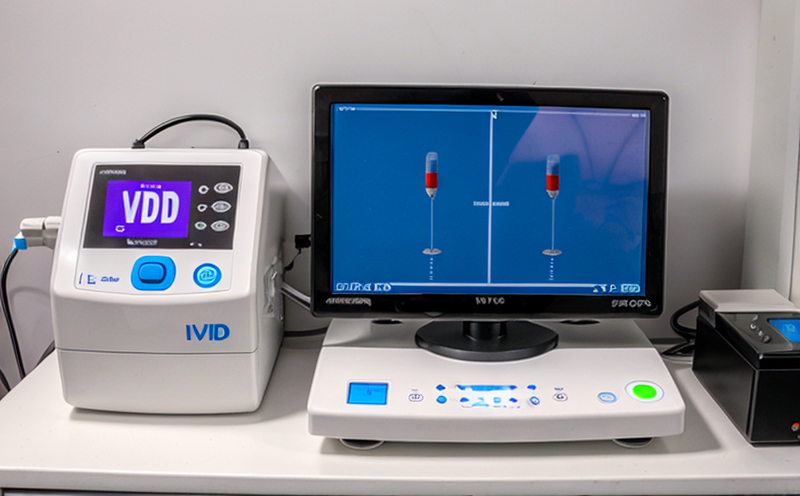Verification of Calibration Materials in IVD Systems
The process of verifying calibration materials in In Vitro Diagnostic (IVD) systems is a critical component of ensuring that medical devices provide accurate and reliable diagnostic results. This service ensures the precision and accuracy of IVD tests, which are essential for patient safety and effective treatment decisions.
Calibration materials play a pivotal role in the calibration process of IVD instruments. They ensure that the instrument readings correspond accurately to the actual concentrations of analytes being measured. This verification is particularly crucial as even slight discrepancies can lead to misdiagnosis, which can have serious implications for patient health.
Our service involves several key steps: selection of appropriate calibration materials, preparation and application in real-world scenarios, instrument setup, data collection, analysis, and reporting. The process adheres to international standards such as ISO 17025 and IVD-REGULATIONS, ensuring that the verification is robust and compliant with regulatory requirements.
The selection of calibration materials involves a rigorous process based on the specific needs of the diagnostic tests. This includes considerations such as stability, reactivity, and compatibility with different types of instrumentation. The preparation phase ensures that the materials are in optimal condition for testing, which is critical for accurate results.
Once prepared, the calibration materials are integrated into the IVD system. This integration involves a series of checks to ensure that the materials are correctly placed and that the system can read them accurately. Data collection is then performed under controlled conditions, with detailed records kept at every stage.
The data collected from these tests are analyzed using statistical methods to determine if the IVD system is calibrated within acceptable limits. This analysis ensures that any discrepancies are identified and addressed promptly. The final step in this process is reporting the results, which includes a comprehensive overview of the calibration verification process, including any deviations from expected values.
| Step | Description |
|---|---|
| Material Selection | Selecting materials based on diagnostic test requirements. |
| Preparation | Ensuring the calibration materials are in optimal condition for testing. |
| Integration | Integrating the materials into the IVD system and performing checks. |
| Data Collection | Gathering data under controlled conditions for analysis. |
| Data Analysis | Using statistical methods to determine calibration accuracy. |
| Reporting | Comprehensive overview of the process and results. |
Why It Matters
The importance of verifying calibration materials in IVD systems cannot be overstated. Accurate diagnosis is a cornerstone of effective patient care. Any discrepancy in the accuracy of an IVD system can lead to misdiagnosis, which can have severe consequences for patients.
Calibration ensures that the results from an IVD test are reliable and consistent. This consistency is crucial for monitoring a patient's condition over time or comparing results across different tests. Without accurate calibration, the reliability of the diagnostic process is compromised, leading to potential errors in treatment decisions.
The verification process not only enhances the accuracy of individual tests but also ensures that the entire system operates within specified limits. This is particularly important given the increasing complexity and sensitivity of modern IVD systems. Regular verification helps maintain these high standards, ensuring that healthcare providers can trust the results they receive from these devices.
The consequences of inaccurate calibration are significant. Misdiagnosis can lead to unnecessary treatments, delays in appropriate care, or even harmful interventions. In severe cases, it could result in patient harm or even death. Ensuring accurate and reliable IVD systems is therefore not just a matter of compliance but also a vital component of patient safety.
- Reduces the risk of misdiagnosis
- Maintains consistency across tests
- Enhances reliability of diagnostic results
- Promotes trust in healthcare providers
- Avoids unnecessary treatments and harmful interventions
International Acceptance and Recognition
The verification of calibration materials in IVD systems is recognized globally as a critical process for ensuring the accuracy and reliability of diagnostic tests. Compliance with international standards ensures that results are accepted across borders, facilitating global healthcare practices.
- ISO 17025: This standard sets requirements for competence and performance of testing laboratories, which is essential for accurate calibration verification.
- IVD-REGULATIONS: Ensures that the calibration process adheres to regulatory standards set by various countries.
The acceptance of these processes in different regions highlights their significance. Countries like the United States, Europe, and Asia all have stringent regulations regarding IVD systems. By adhering to international standards, laboratories ensure that their verification processes are recognized worldwide, enhancing global cooperation in healthcare.
Use Cases and Application Examples
| Use Case | Description |
|---|---|
| Blood Glucose Monitoring Systems | Verification of calibration materials ensures accurate glucose readings, critical for diabetic patients. |
| HIV Testing Kits | Avoiding discrepancies in HIV test results is crucial for early diagnosis and treatment. |
| Cancer Marker Tests | Accurate calibration of cancer marker tests is vital for detecting and monitoring the disease. |
| Pregnancy Testing Kits | Verification ensures reliable pregnancy test results, which can have significant psychological impacts on patients. |





